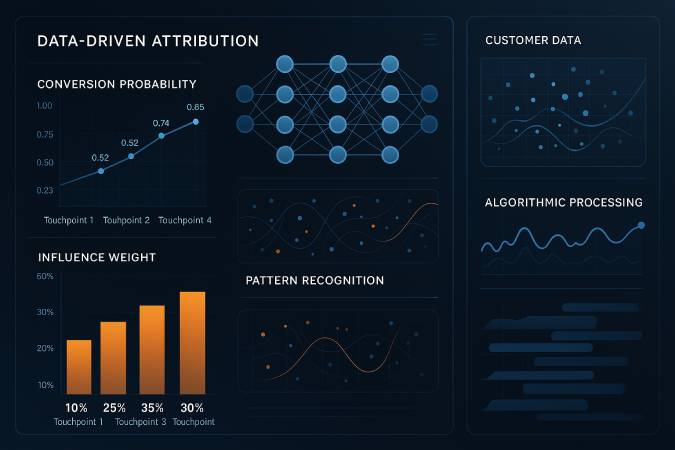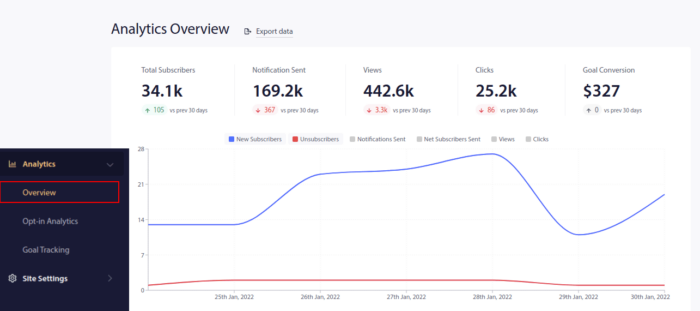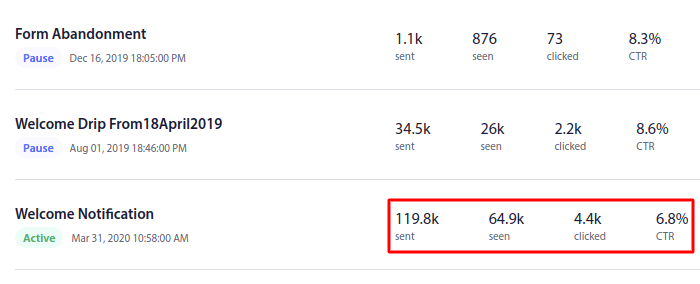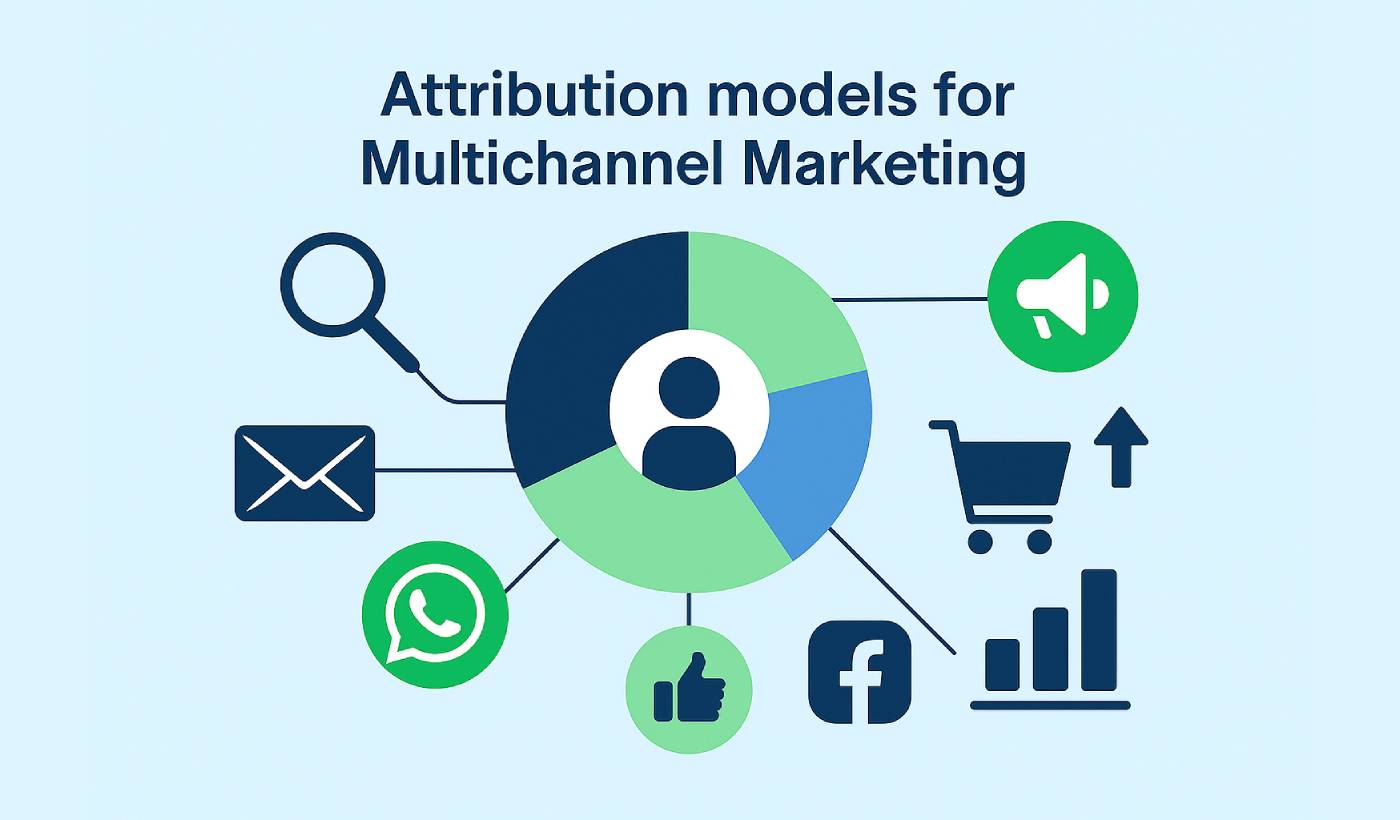The attribution model you choose can dramatically influence your understanding of which channels are truly driving results, potentially leading to significant shifts in marketing strategy and resource allocation.
However, with numerous attribution models available—from simple single-touch approaches to sophisticated machine learning algorithms—choosing the right model for your specific business needs can feel overwhelming. Each model offers different perspectives on the customer journey, and what works perfectly for one business might provide misleading insights for another.
We’ll explore how multichannel marketing through platforms like PushEngage fits into the attribution landscape, providing valuable touchpoint data that enhances your overall understanding of customer journey effectiveness.
Send Multichannel Messages Today!
Push and WhatsApp messaging are super effective, low-cost marketing tools to help you grow your repeat traffic, engagement, and sales on autopilot.
- Understanding Marketing Attribution
- Single-Touch Attribution Models
- Multi-Touch Attribution Models
- Advanced Attribution Models
- Choosing the Right Attribution Model
- Attribution in Different Marketing Channels
- Implementation Best Practices
- Future of Marketing Attribution
- Frequently Asked Questions
- What's the difference between single-touch and multi-touch attribution?
- How do I know if my business has enough data for data-driven attribution?
- How does PushEngage help with attribution tracking?
- What should I do if my attribution data shows conflicting insights?
- How often should I review and update my attribution model?
- Your Next Steps
Understanding Marketing Attribution
Marketing attribution represents the analytical process of identifying and assigning credit to the various marketing touchpoints that influence a customer’s decision to convert. At its core, attribution seeks to answer the fundamental question that has challenged marketers since the dawn of advertising: which half of my marketing budget is working, and which half is wasted?
The concept of attribution has evolved significantly from the early days of digital marketing when most businesses relied on simple last-click attribution, giving full credit to whichever channel drove the final interaction before conversion. This approach worked reasonably well when customer journeys were simpler and fewer digital touchpoints existed, but the explosion of marketing channels and the increasing sophistication of customer behavior has rendered single-touch attribution models inadequate for most modern businesses.
Today’s customers interact with brands across an average of six to eight touchpoints before making a purchase decision. These interactions might span weeks or months and include a complex mix of paid advertising, organic search, social media engagement, email marketing, push notifications, direct website visits, and offline interactions. Each touchpoint plays a potentially important role in moving the customer closer to conversion, yet traditional attribution models often fail to capture this nuanced reality.

Single-Touch Attribution Models
Single-touch attribution models represent the simplest approach to marketing attribution, assigning 100% of conversion credit to a single touchpoint in the customer journey. While these models lack the sophistication to capture the full complexity of modern customer behavior, they remain valuable for specific use cases and provide important insights when used appropriately.
First-Touch Attribution
First-touch attribution assigns complete conversion credit to the initial touchpoint that introduced a customer to your brand. This model operates on the principle that customer acquisition begins with awareness, and the channel responsible for that first interaction deserves full credit for any eventual conversion, regardless of how many additional touchpoints occur before the purchase.
The primary strength of first-touch attribution lies in its ability to identify which marketing channels excel at generating initial awareness and attracting new prospects to your brand. For businesses focused on brand building and customer acquisition, understanding which channels consistently introduce high-quality prospects provides valuable insights for top-of-funnel optimization and awareness campaign planning.
However, first-touch attribution suffers from significant limitations that make it inappropriate as a standalone attribution approach for most modern businesses. By ignoring all touchpoints after the initial interaction, this model fails to account for the nurturing, education, and persuasion that typically occur throughout the customer journey.
Last-Touch Attribution
Last-touch attribution represents the opposite approach from first-touch, assigning 100% of conversion credit to the final touchpoint before a customer converts. This model assumes that the last interaction a customer has with your brand before purchasing is the most influential factor in their decision-making process and therefore deserves complete credit for the conversion.
The appeal of last-touch attribution lies in its simplicity and intuitive logic—the touchpoint that immediately precedes conversion appears to be the direct cause of the purchase decision. For businesses with short sales cycles and straightforward customer journeys, last-touch attribution can provide clear insights into which channels and campaigns are most effective at closing sales and driving immediate conversions.
However, last-touch attribution suffers from the fundamental flaw of completely ignoring the customer journey that leads to the final conversion touchpoint. A customer might engage with your brand through multiple awareness and consideration touchpoints over several weeks before finally converting through a direct website visit—last-touch attribution would give the direct visit full credit while ignoring all the marketing efforts that built awareness and interest throughout the journey.
Multi-Touch Attribution Models
Multi-touch attribution models acknowledge the reality that modern customer journeys involve multiple touchpoints, each potentially contributing to the eventual conversion decision. These models distribute conversion credit across multiple interactions rather than assigning all credit to a single touchpoint, providing a more nuanced understanding of how different marketing channels work together to drive results.

Linear Attribution
Linear attribution represents the most straightforward approach to multi-touch attribution, distributing conversion credit equally across all touchpoints in the customer journey. If a customer interacts with your brand through five different touchpoints before converting, each touchpoint receives 20% of the conversion credit, regardless of when the interaction occurred or what type of engagement it represented.
The primary advantage of linear attribution lies in its democratic approach to crediting marketing touchpoints. This model recognizes that every interaction potentially contributes to the customer’s eventual decision to convert, ensuring that no touchpoint is completely ignored in attribution analysis.
Time-Decay Attribution
Time-decay attribution operates on the principle that touchpoints occurring closer to the conversion event are more influential in the customer’s final purchase decision than those occurring earlier in the journey. This model assigns increasing amounts of conversion credit to touchpoints as they approach the conversion event, with the most recent interactions receiving the highest credit and earlier touchpoints receiving progressively less credit.
The logic behind time-decay attribution reflects common patterns in human decision-making, where recent information and experiences often carry more weight than older ones. In marketing contexts, this translates to the assumption that touchpoints occurring closer to the purchase decision are more likely to be the decisive factors that push customers from consideration to conversion.
Position-Based (U-Shaped) Attribution
Position-based attribution, commonly known as U-shaped attribution due to its credit distribution pattern, represents a compromise between single-touch and equal-weight multi-touch approaches. This model assigns the highest credit to the first and last touchpoints in the customer journey—typically 40% each—while distributing the remaining 20% equally among all middle touchpoints.
The U-shaped approach reflects the common marketing wisdom that customer acquisition begins with awareness and ends with conversion, making both the first and last touchpoints particularly important in the overall journey. By giving substantial credit to both ends of the customer journey while still acknowledging middle touchpoints, this model attempts to balance the insights provided by first-touch and last-touch attribution while recognizing the multi-touch reality of modern customer behavior.
Advanced Attribution Models
Data-Driven Attribution
Data-driven attribution represents the most sophisticated approach to marketing attribution, using machine learning algorithms to analyze actual customer behavior patterns and assign conversion credit based on statistical analysis of how different touchpoints influence conversion likelihood. Rather than relying on predetermined rules or assumptions about customer behavior, data-driven models examine historical data to identify which touchpoint combinations and sequences are most strongly correlated with conversions.
The fundamental advantage of data-driven attribution lies in its ability to discover actual influence patterns rather than assuming them. Traditional rule-based attribution models make assumptions about customer behavior—such as the idea that recent touchpoints are more influential or that first and last touchpoints deserve the most credit—but data-driven models let the data reveal the true patterns of influence within your specific customer base.
Google Analytics 4 and Google Ads have made data-driven attribution their default approach, reflecting the industry’s recognition that algorithmic models typically provide more accurate insights than rule-based alternatives. These platforms analyze millions of customer journeys to identify patterns that would be impossible for humans to detect manually.
Choosing the Right Attribution Model
Selecting the appropriate attribution model for your business requires careful consideration of multiple factors that influence both the accuracy of attribution insights and their practical utility for marketing optimization. The right choice depends on your specific business characteristics, customer behavior patterns, marketing strategy, and organizational capabilities.
Business Characteristics and Sales Cycle Considerations
The length and complexity of your sales cycle represents one of the most important factors in attribution model selection. Businesses with short sales cycles—typically measured in hours or days—often find that simpler attribution models provide sufficient insights for optimization decisions. When customers discover your brand and convert quickly, the number of touchpoints is naturally limited, making single-touch or simple multi-touch models reasonable approximations of actual influence patterns.
Conversely, businesses with extended sales cycles require more sophisticated attribution approaches that can account for the numerous touchpoints that occur over weeks or months. B2B companies selling enterprise software, educational institutions recruiting students, and businesses offering high-value services often see customer journeys that span multiple months and include dozens of touchpoints across various channels.
Customer Journey Patterns and Touchpoint Analysis
Understanding your typical customer journey patterns provides crucial insights for attribution model selection. Businesses should analyze their customer data to identify common journey characteristics such as average number of touchpoints, typical time between first interaction and conversion, and the most common channel sequences that lead to conversions.
Some businesses discover that their customers follow relatively predictable journey patterns, such as discovering the brand through content marketing, engaging with email nurturing campaigns, and converting through direct website visits. In these cases, position-based attribution might provide reasonable insights by giving appropriate credit to the awareness and conversion touchpoints while acknowledging the nurturing activities in between.
Attribution in Different Marketing Channels
Understanding how attribution works within specific marketing channels helps optimize both individual channel performance and cross-channel coordination. Each marketing channel presents unique attribution challenges and opportunities that require tailored approaches for accurate measurement and optimization.
Push Notification Attribution with PushEngage
Push notifications represent a unique attribution opportunity due to their immediate delivery, high visibility, and direct connection to specific customer actions. PushEngage provides comprehensive attribution tracking that helps businesses understand how push notifications contribute to conversions both as standalone touchpoints and as part of broader multi-channel customer journeys.

Push notification attribution through PushEngage tracks not only direct conversions from push notification clicks but also the broader influence of push notifications on customer behavior and purchase intent. This includes measuring how push notifications drive website visits, email signups, social media engagement, and other valuable customer actions that contribute to eventual conversions.
The timing and context of push notifications make them particularly powerful attribution touchpoints. Unlike email or social media, push notifications appear immediately on customer devices and can be delivered at optimal moments based on customer behavior and preferences. PushEngage’s attribution tracking captures this timing advantage and helps businesses understand how strategic push notification delivery influences conversion likelihood.
Segmentation and personalization capabilities within PushEngage enable sophisticated attribution analysis that measures the incremental impact of targeted messaging. Businesses can compare the attribution performance of generic push notifications versus personalized messages based on customer behavior, purchase history, and engagement patterns.

Integration between PushEngage and other marketing platforms provides comprehensive attribution insights that show how push notifications work in combination with email marketing, social media, paid advertising, and other channels. This integration enables businesses to optimize their multi-channel strategies and understand the unique role that push notifications play in their overall marketing mix.
The high engagement rates typical of push notifications—often exceeding 90% open rates—make them valuable attribution touchpoints that can significantly influence customer journey analysis. When customers consistently engage with push notifications, these interactions provide strong signals about customer interest and purchase intent that enhance overall attribution accuracy.
Implementation Best Practices
Successfully implementing marketing attribution requires careful planning, systematic execution, and ongoing optimization. The technical and organizational challenges of attribution implementation often determine whether businesses realize the full value of their chosen attribution models.
Technical Implementation Requirements
Effective attribution implementation begins with comprehensive data collection across all marketing touchpoints. This requires implementing consistent tracking mechanisms that can identify and connect customer interactions across different channels, devices, and time periods. The foundation of accurate attribution lies in the quality and completeness of the underlying data.
Modern attribution implementation typically involves deploying tracking pixels, implementing UTM parameters consistently across all campaigns, setting up conversion tracking for all important business outcomes, and ensuring that customer identifiers can be matched across different touchpoints. This technical foundation must be established before any attribution model can provide accurate insights.
Data Quality and Consistency Management
Attribution accuracy depends heavily on data quality and consistency across all touchpoints. Inconsistent tracking implementations, missing data, and attribution gaps can create misleading insights that lead to poor marketing decisions.
Establishing data governance processes ensures that all marketing activities are tracked consistently and that data quality issues are identified and resolved quickly. This includes implementing standardized naming conventions for campaigns and channels, regular audits of tracking implementations, and systematic processes for handling data discrepancies.
Future of Marketing Attribution
The marketing attribution landscape continues evolving rapidly in response to privacy regulations, technological advances, and changing customer behavior patterns. Understanding these trends helps businesses prepare for the future of attribution and make strategic decisions about their measurement approaches.
Privacy-First Attribution Strategies
The shift toward privacy-first marketing has fundamentally changed how businesses approach attribution tracking and analysis. Traditional methods that relied heavily on third-party cookies and cross-site tracking are becoming less reliable, forcing businesses to develop new approaches that respect customer privacy while maintaining measurement accuracy.
First-party data strategies become increasingly important as businesses need to collect attribution data directly from customer interactions rather than relying on third-party tracking networks. This includes implementing customer login systems, encouraging email signups, and creating value exchanges that motivate customers to share identifying information voluntarily.
Artificial Intelligence and Machine Learning
Advanced AI and machine learning technologies are transforming attribution analysis by enabling more sophisticated pattern recognition and predictive capabilities than traditional rule-based models. These technologies can identify complex relationships between marketing touchpoints and customer behavior that would be impossible to detect manually.
Predictive attribution models use machine learning to forecast the likely impact of different marketing touchpoints before conversions occur. This enables real-time optimization of marketing campaigns based on predicted attribution outcomes rather than waiting for historical analysis.
Frequently Asked Questions
What’s the difference between single-touch and multi-touch attribution?
Single-touch attribution assigns 100% of conversion credit to one touchpoint in the customer journey—either the first interaction (first-touch) or the last interaction (last-touch) before conversion. Multi-touch attribution recognizes that modern customer journeys involve multiple touchpoints and distributes conversion credit across several interactions based on different weighting schemes.
How do I know if my business has enough data for data-driven attribution?
Data-driven attribution typically requires thousands of conversions and touchpoints to identify reliable patterns. Google Analytics 4 recommends at least 3,000 conversions and 300 conversions per month for their data-driven model to function effectively. Businesses with fewer conversions should start with rule-based attribution models while building their data volume.
How does PushEngage help with attribution tracking?
PushEngage provides comprehensive attribution tracking that measures both direct conversions from push notification clicks and the broader influence of push notifications on customer behavior. The platform integrates with other marketing tools to provide unified attribution analysis across all touchpoints, helping businesses understand how push notifications work in combination with other marketing channels to drive results.
What should I do if my attribution data shows conflicting insights?
Conflicting attribution insights often indicate data quality issues, tracking inconsistencies, or the need for more sophisticated attribution approaches. Start by auditing your tracking implementations to ensure consistent data collection across all touchpoints. Consider whether your current attribution model accurately reflects your customer journey patterns.
How often should I review and update my attribution model?
Attribution models should be reviewed quarterly and updated when significant changes occur in your marketing strategy, customer behavior patterns, or business model. Major changes such as launching new marketing channels, entering new markets, or shifting target audiences often require attribution model adjustments.
Your Next Steps
Marketing attribution represents one of the most critical yet challenging aspects of modern digital marketing strategy. The attribution model you choose fundamentally shapes how you understand customer behavior, measure marketing effectiveness, and allocate resources across different channels and campaigns.
For businesses just beginning their attribution journey, starting with simpler models while building data collection capabilities and organizational understanding provides a practical foundation for future sophistication. First-touch and last-touch attribution, despite their limitations, offer clear insights into awareness and conversion effectiveness that can guide initial optimization efforts.
Either way, don’t wait. Your customers are already using WhatsApp. The question is: Will you meet them there?
Start with whichever method feels right for your business. You can always upgrade to a more sophisticated solution later. The important thing is to get started and begin building those direct customer relationships that WhatsApp makes possible.
Your customers will thank you for making it easy to reach you. And your business will thank you for the increased engagement and conversions that come with better customer communication.
- Why Mobile App Push Notifications Are Great for Your App
- Mobile App Engagement Strategy for New App Builders
- What App Engagement Metrics Should You Look At
- What Are Push Notifications? A Simple Guide for Epic Results
- Push Notification Cost: Is It Really Free? (Pricing Analysis)
That’s all for this one.
